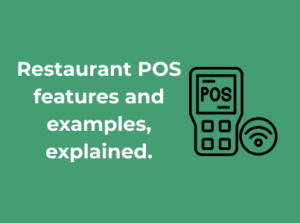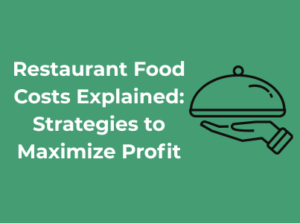Hello, restaurant enthusiasts! Let’s dive into a topic that might not sound as exciting as a sizzling steak, but trust me, it’s crucial to your restaurant’s success: inventory variance. In simple terms, inventory variance is the difference between the inventory you record and the actual stock on hand. Noticed the liquor bottles disappearing faster than the receipts suggest? That’s an example of inventory variance.
Why does this matter so much? Well, in the fast-paced world of restaurants, every penny counts. Your food and beverage inventory are among your highest costs, and even small discrepancies can eat away at your profits. So, whether you’re flipping burgers at a trendy diner or running a fine-dining Michelin-starred establishment, understanding these pesky mismatched numbers is the first step to safeguarding your bottom line.

Breaking Down Inventory Variance
Let’s get a bit deeper into exactly what contributes to these discrepancies. Inventory variance usually stems from two key areas:
- Theoretical Inventory: This is what your system (or your own calculations) tells you that you should have on hand based on sales, purchases, and recipes. It’s the “perfect world” scenario where every order is perfectly tracked.
- Physical Inventory: This is what you actually have, counted during a stock take. This part involves old-fashioned checks by hand – or, if you’re tech-savvy, through digital tools.
The variance is the difference between these two figures – the ideal and the real – and it’s your job to figure out why they don’t match.
Why Does Inventory Variance Happen?
While we won’t dive into all the nitty-gritty causes (spoiler alert: that’s for later sections), here’s a sneak peek: variances can crop up from employee errors, theft, over-portioning, supplier inconsistencies, or even wasteful kitchen practices. Identifying it is step one, addressing it is step two, and preventing it long-term is step three.
The Hidden Value of Tracking Variance
Staying on top of inventory variance isn’t just about avoiding losses – it’s also a valuable chance to streamline your operations. Letting numbers slip through the cracks can lead to over-ordering, unnecessary food waste, and missed opportunities to boost efficiency. Knowledge is power, and having a clear understanding of variance empowers you to make smarter decisions for your restaurant.
Common Causes: Tracing the Source of Discrepancies
Let’s get real for a moment—inventory variance in restaurants can be a total headache! One day your stock levels appear balanced, and the next, there’s a glaring gap between what you think you have and what’s actually there. So, what gives? Pinpointing the source of discrepancies is absolutely critical because solving a problem starts with understanding what’s causing it. Let’s dive into the common culprits, shall we?
1. Human error: The classic culprit
Even in this age of technology, good old-fashioned human mistakes still top the list. From miscounting inventory during stock-takes to inputting incorrect numbers into your system, mistakes happen. Whether someone skips a shelf during the count or enters “100” instead of “10” on a report, small human errors can lead to surprisingly large variances over time.
How to tackle it: Accuracy starts with proper training. Make sure your staff knows how to properly count and record inventory—and encourage them to take their time. Plus, consider introducing checks and balances, like two-person verification systems for key inventory procedures. Teamwork saves the day!
2. Portioning problems: When serving sizes miss the mark
Every dish has a recipe, right? But what happens if your chefs or bar staff aren’t sticking to those exact portion sizes? Over-pouring that glass of wine or tossing in an extra handful of fries might make a customer’s day, but it wreaks havoc on your inventory consistency. Portion inconsistencies are sneakier than they seem and can account for those nagging inventory shortfalls.
How to tackle it: Standardize portion sizes with clear guidelines. Invest in tools like portioning scoops, scales, and measured pours for consistent serving, and educate your staff about staying within the recipes. That way, you’ll control both costs and variance without sacrificing quality.
3. Loss: Theft, spoilage, and waste
Not all inventory variance comes from innocent mistakes. Sometimes the issue is theft—whether it’s a bottle of wine disappearing off the shelf or someone taking home extra meals. On the flip side, spoilage and over-preparation also account for significant losses, especially with perishable ingredients in a fast-paced restaurant environment.
How to tackle it: To combat theft, implement measures like restricting access to high-value inventory and keeping your stock secured. For spoilage, focus on better forecasting and rotating stock using FIFO (First In, First Out) methods. Tracking waste data is also critical—find out what’s being thrown away and adjust your purchasing or production accordingly. Knowledge is power!
4. Supplier inconsistencies
Ever notice that some deliveries fall short of what you ordered? Or maybe they include damaged goods? These supplier-related issues are another sneaky cause of inventory variance, and they can quickly throw your numbers off if not immediately addressed.
How to tackle it: Keep a close eye on incoming deliveries. Implement a practice of checking and counting items as they arrive and comparing against purchase orders. If you spot recurring supplier errors, communicate directly with the vendor—or consider switching to a more reliable one.
5. Poorly managed inventory systems
Sometimes, the tools you use (or neglect to use) are the root of the problem. Relying on outdated spreadsheets or managing stock manually is a risky game that increases the chance of error. Without real-time tracking, discrepancies can pile up unnoticed until it’s too late.
How to tackle it: Upgrade to a modern inventory management system! Tools equipped with real-time tracking, automation, and analytical features minimize manual input errors and give you a clearer snapshot of your inventory.
The Price Tag of Neglect: Financial and Operational Impact of Variance
Let’s talk about the real-world consequences of inventory variance. When restaurant owners throw up their hands and chalk it up to “just the way it is,” they may not fully grasp the financial and operational sinkhole they’re stepping into. Inventory variance isn’t just a minor inconvenience; it’s a silent profit killer—and it can ripple into almost every aspect of your business if left unaddressed.
The Financial Impact: Death by a Thousand Cuts
Think inventory variance is just numbers on a spreadsheet? Think again. When discrepancies pile up over time, they can amount to a serious dent in your bottom line. Here’s how:
- Lost Revenue: Missing ingredients mean you can’t serve menu items as planned, leading to lost opportunities for revenue. Imagine a customer craving your signature dish, only to find it’s unavailable. That’s both a lost sale and a disappointed guest who may not return.
- Inaccurate Costing: How can you price your dishes effectively if you’re not sure how much ingredients truly cost? Inventory variance makes it nearly impossible to calculate food costs accurately, undermining your ability to remain profitable and competitive.
- Wasteful Spending: If stock levels don’t align with reality, you’re likely to order more of what you already have—or worse, miss replenishing what you’re actually low on. Both mistakes result in avoidable expenses, whether it’s from over-purchasing or product shortages forcing you to expedite deliveries (hello, extra shipping fees).
- Shrinkage and Theft: While most variance is unintentional, some is deliberate. Poor tracking can open the door for employee theft or misuse, further draining resources.
The Operational Cost: Productivity Takes a Hit
It’s not just your bank account that suffers—inventory variance sneaks into your day-to-day operations, disrupting workflow and morale. Consider this:
- Stressful Shifts: Ever watch your kitchen staff scramble because an ingredient unexpectedly ran out? It’s chaotic, and it forces your team to improvise or halt service altogether. Both scenarios create stress and increase the likelihood of errors during service.
- Extra Hours: Mismanaged inventory means someone has to spend more time fixing mistakes. Endless recounts, emergency supply runs, and additional audits steal time that could be spent on more productive tasks (or even just resting).
- Lack of Trust: Variance issues can erode employee trust. If staff see inconsistent stock levels or frequently experience shortages, they may question leadership’s competence or cut corners—a vicious cycle that worsens the problem.
Why Ignoring Variance is Like Ignoring a Leak
Picture a slow leak in your roof. It might seem manageable at first—until it rots the beams, floods the floors, and leaves you with a repair bill you’d rather not see. Inventory variance is no different. What starts as small discrepancies can spiral into bigger, harder-to-ignore challenges, from rising food costs to frustrated staff and unhappy customers.
Spotting Red Flags: How to Detect Early Signs of Variance
When it comes to managing a restaurant, inventory variance can be one of those sneaky challenges that quietly creeps up on you until it’s causing real trouble. But guess what? If you know how to spot the early warning signs, you can address issues before they spiral out of control. So, let’s break down some telltale signs to watch out for, and how to steer your inventory ship back on course.
Unusual Patterns in Usage Reports
Your inventory usage reports can tell a story—if you know how to read them. One of the easiest ways to detect inventory variance is by looking out for usage patterns that just don’t make sense. For example, let’s say your sales data shows that you sold 100 hamburgers last week, but somehow you’re missing enough beef patties for 120. That’s a red flag right there.
Pro Tip: Make it a habit to reconcile your sales data with inventory usage regularly—weekly checks work wonders. This makes catching discrepancies a part of your routine rather than a once-in-a-while scramble.
Consistent Shortages of High-Cost Items
Are you constantly running out of premium products like cuts of meat, seafood, or specialty alcohol? These high-ticket items are prime suspects when it comes to inventory variance. Whether it’s wastage or shrinkage (a polite way of saying theft), persistent shortages demand closer scrutiny.
What to Do: Use a regular inventory count system for high-value items, keeping accurate records of what’s coming in and going out. The sooner you notice a trend, the quicker you can address its root cause.
Spikes in Food Costs Compared to Sales
Even without diving deep into your stockroom, your profit margins can hold clues to inventory variances. If your food costs are eating up a larger percentage of your revenue than usual—without a corresponding bump in sales—it’s time to dig deeper. Are ingredients being wasted during prep? Is the team over-portioning? Are items mysteriously walking out the door?
Eager to tackle this? Create an escalation plan to identify where the hemming of funds is happening and consider re-training your team on portion control and prep best practices.
Inventory Counts Rarely Match Expectations
Let’s be honest—doing inventory isn’t anyone’s favorite task. But if you notice that your physical counts barely ever match what’s on paper (or in your software), you’ve got a problem that needs immediate attention. Regular discrepancies could point to anything from data entry errors to brewing employee-related issues.
Keep in Mind: Having a system in place that combines manual counting with inventory management tools can reduce human error and immeasurably improve accuracy over time.
Mistakes That Keep Repeating Themselves
A repeated small error is often a clue to bigger underlying issues. Are orders being put in incorrectly? Do deliveries always come up short? Are storage procedures lax, allowing food to spoil or go missing before anyone notices? Repeated patterns like this are telling you something—so listen!
Solution: Train your staff on standardized ordering and storage protocols, and create a checklist to ensure everyone adheres to the process.
Trust Your Gut (and Your Data!)
Aside from visible signs, sometimes it’s your sixth sense that something’s off. If you notice that inventory doesn’t feel as consistent as it should, don’t ignore the hunch. A deep dive into your records might confirm what your instincts are telling you.
The Role of Software: Integrating Solutions to Combat Variance
Let’s be honest, managing inventory in restaurants can feel like juggling flaming torches. From tracking ingredients to ensuring accurate ordering, the task can be overwhelming. And when variances sneak in—those pesky discrepancies between what you expected to have on hand and what’s actually left—it can cost not only money but also time and mental energy. Fortunately, this is where technology steps in as the calm, collected assistant that keeps your operations running smoothly.
The Power of Restaurant-Specific Software
Gone are the days of meticulously counting items with paper and pencil or relying on a gut feeling about why you’re running out of mozzarella so quickly. Today’s restaurant inventory management software does the heavy lifting for you. These tools are designed specifically to track inventory levels, predict orders based on usage patterns, and highlight variances before they spiral out of control. The result? You spend less time stressing over spreadsheets and more time focusing on delivering incredible food and guest experiences.
Wondering what makes software so effective in combating inventory variance? Here are a few capabilities to look for:
- Real-Time Tracking: The best platforms offer real-time data insights into stock levels, so you know exactly where your inventory stands at any given moment.
- Integration with Sales Systems: By syncing with your POS (point of sale) system, inventory management software can automatically calculate inventory usage based on actual sales.
- Variance Reporting: Many tools can highlight variances in a way that’s easy to understand, helping you identify theft, waste, or errors without digging through mountains of data.
- Automatic Reordering: Never worry about running out of essential items again! Smart reordering features ensure your shelves stay stocked while minimizing overstocking.
How Software Simplifies Troubleshooting
When variances occur, the right software turns from just a tool into a full-blown detective. Instead of scrambling to figure out whether the shortage was due to human error, supplier mistakes, or unrecorded waste, inventory software gives you the evidence. For example, you might notice a spike in missing beer bottles. With the software’s analytics, you can cross-check sales data and inventory numbers to pinpoint whether these items weren’t recorded in the POS or if spillage during service might be the culprit.
The ROI of Investing in Technology
If you’re worried about the upfront costs of implementing a software solution, let’s flip that thought on its head. Imagine reducing food waste by 15% or bringing variance down to near-zero levels. Over time, these improvements add up to significant savings—dollars that go back into your profit margins instead of vanishing into thin air. Plus, tools that streamline inventory management lighten the workload on your staff, improving efficiency and freeing them to focus on their core tasks.
Tips for Choosing the Right Tool
Before you commit to a platform, do your homework. Here’s what to keep in mind:
- Usability: The software should be intuitive and easy for your entire team to learn.
- Scalability: Choose a tool that can grow with you, whether you’re managing one restaurant or a multi-location empire.
- Customer Support: Look for a provider with stellar customer service to help whenever you’re stuck.
- Features That Match Your Needs: Not every restaurant needs every feature. Think about whether you need things like recipe costing, supplier integrations, or theft tracking, and pick accordingly.
Beyond Technology: Building a Strong Culture of Inventory Accountability
While tech solutions are a game-changer for managing inventory variance, not everything boils down to software. The human element is just as vital, if not more so. Building a culture of accountability within your restaurant is the secret sauce that ensures consistent success. Let’s talk about why fostering good habits, communication, and teamwork is just as important as that fancy new inventory app.
The Foundation: Why Culture Matters
Think about it: software can only do what it’s told. It’s the people using it who determine its effectiveness. If your staff isn’t invested in inventory processes or doesn’t fully understand their role, even the best tools will fall short. A strong culture of accountability serves as the foundation for avoiding these pitfalls because it ensures that every employee, from the line cook to the general manager, feels empowered and responsible for protecting the restaurant’s resources. When people care, variance shrinks—simple as that!
Encouraging Ownership Among Your Team
Accountability starts with ownership. Your team needs to feel like they have a stake in the restaurant’s success. Here are some ways to make this happen:
- Start with Training: Teach employees why inventory management is essential. Connect it to things they care about—like ensuring premium ingredients are always available or avoiding waste that could impact the menu.
- Set Clear Expectations: When protocols are crystal clear, it’s easy to follow them. Develop standard operating procedures (SOPs) and get everyone on board with routines like logging inventory counts accurately and immediately reporting discrepancies.
- Incentivize Accuracy: Reward your team for hitting inventory accuracy goals. Whether it’s shout-outs during team meetings, gift cards, or even small bonuses, recognition goes a long way in reinforcing good habits.
Lead by Example
Your leadership sets the tone for the culture. If managers treat inventory audits and checks as optional or last-minute chores, so will employees. But when management takes inventory seriously and visibly follows best practices, it sends a clear message that every ounce of waste matters.
The motto here? “Inspect what you expect.” If you’re regularly engaged in the process and paying attention to how inventory is being handled, your team will naturally rise to meet the standard.
Promote Communication and Collaboration
Mistakes happen—it’s part of the job. What truly matters is creating an environment where team members feel they can speak up about issues without fear of blame. Encourage open dialogue, whether it’s about a suspected theft, ingredient shortages, or miscommunications during shift changes. Teams that communicate well are better equipped to spot and solve inventory issues early on.
Fostering a “Waste Not” Mentality
Another major element is embedding a waste-conscious mindset into the culture of your restaurant. Help employees see waste for what it really is: lost revenue—and often unnecessary loss. Enforce simple habits, like rotating stock properly with FIFO (First In, First Out) principles and keeping a close eye on slow-moving items before they spoil.
Make it fun! Turn waste reduction into a team challenge or goal and celebrate when significant improvements are made. People love being part of something bigger than their individual roles, and focusing on waste reduction makes those wins tangible and meaningful.
Accountability is Ongoing
Cultural change doesn’t happen overnight. Building accountability around inventory management is an ongoing effort, requiring constant attention, positive reinforcement, and mutual trust. The beauty of this approach is that it pays off in more than just variance reduction—teams with strong accountability tend to work more cohesively and feel a greater sense of pride in their daily work. And that’s something technology alone can’t achieve.

Real-Life Insights: Success Stories from Restaurants Tackling Variance
Let’s take an inspiring journey into the world of restaurants that have turned their inventory situations around. Learning from real-life examples makes everything a bit more tangible, doesn’t it? These case studies show that with the right strategies and a bit of persistence, tackling inventory variance isn’t just achievable—it can lead to remarkable improvements in profitability, efficiency, and team morale. Ready? Let’s dive in!
The Tale of the Missing Shrimp: A Family-Owned Bistro’s Turnaround
This family-owned seaside bistro was struggling with consistent inventory discrepancies. The owners noticed that their shrimp supply regularly ran out faster than customer orders could explain. After months of frustration, they decided it was time to get serious about their inventory tracking practices.
They implemented weekly staff meetings to create open communication about inventory procedures. By launching a spot-check protocol on high-value items like shrimp, they discovered that their portion sizes weren’t standardized. Once they addressed this by training kitchen staff and introducing pre-portioned packs, their shrimp losses dropped by 25% in a single month! The owners now proudly share that tightening inventory controls gave them the confidence to experiment with more seafood specials, which boosted sales as well.
From Chaos to Control: A Fast-Food Joint’s Leap into Digital Systems
A busy fast-food restaurant in downtown Chicago was drowning in manual inventory logs. Food discrepancies were rampant, and the employees dreaded the monthly stock count. The owner realized it wasn’t enough to “just get by.” They needed a better system—and fast.
The solution? Adopting an inventory management software. The program integrated directly with their Point-of-Sale (POS) system, automatically updating stock levels in real time as orders were placed. Suddenly, they could see clear trends, like which ingredients were over-ordered or wasted most often.
- What changed? Wastage dropped by 30% within two months.
- Unexpected benefit: Employees felt less stressed because they weren’t buried in paperwork, allowing them to focus on providing great customer service.
Collaboration is Key: A Fine Dining Spot’s Team-Centered Approach
At a fine dining restaurant in New York, the problem wasn’t theft or waste alone—it was lack of teamwork. Kitchen staff blamed waitstaff for “overordering,” while waitstaff pointed fingers at the bar team for not tracking liquor usage properly. It was a blame game with no winners, but the restaurant’s general manager had a hunch that the solution lay in building a stronger sense of shared responsibility.
The manager organized cross-department training sessions where different teams shared their challenges and learned about how their roles impacted overall inventory management. They also introduced a monthly incentive: If the variance stayed below a threshold, staff would get a shared bonus.
- Within months, the blame game dwindled.
- Each team started taking ownership of their roles, from bartenders precisely logging pour counts to servers accurately entering customer orders.
Today, the restaurant boasts one of the lowest inventory variances in their region. Their secret? A unified team that sees inventory management as everyone’s responsibility—not just one person’s headache.





